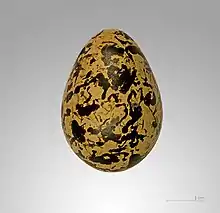| Greater painted-snipe | |
|---|---|
_I2_IMG_9477.jpg.webp) | |
| Male on water | |
| Scientific classification | |
| Domain: | Eukaryota |
| Kingdom: | Animalia |
| Phylum: | Chordata |
| Class: | Aves |
| Order: | Charadriiformes |
| Family: | Rostratulidae |
| Genus: | Rostratula |
| Species: | R. benghalensis |
| Binomial name | |
| Rostratula benghalensis | |
 | |
| Distribution | |
| Synonyms | |
| |
The greater painted-snipe or goudsnip (Rostratula benghalensis) is a species of wader in the family Rostratulidae. They are widely distributed across Africa and southern Asia. The birds are found in a variety of wetland habitats, including swamps and the edges of larger water bodies such as lakes and rivers.
Classification
The greater painted-snipe was first described by Carl Linnaeus. The related species Rostratula australis of Australia is endangered, and was formerly a subspecies of R. benghalensis.[2]
Distribution
Greater painted-snipe are very widely distributed; in mainland Africa as well as Madagascar and the Seychelles; in India, and Southeast Asia.[3][4] Within Africa, they are found in the Nile River Valley and in the non-rainforested areas of Sub-Saharan Africa. They are notably absent from the eastern portion of Somalia, from the desert areas of Namibia, and from parts of Botswana and South Africa.[5] Despite their wide distribution, they are uncommon within their range.[5] There are between 31,000 and 1,000,000 mature individuals alive, according to BirdLife International.[6]
Description

The greater painted-snipe are medium-sized shorebirds found in wetland habitat.[7] The birds display sexual dimorphism: females of the species are larger, heavier, and have bolder plumage than the males (see image, left). The females have "dark bronze green upperparts", and an area of castaneous feathers that extends from the lower head area to the chest. They also have a large white eyepatch. By contrast, the males are largely mottled grey and brown, with buff-coloured upper parts. This gives them very strong camouflage when they are in their nests.[3]
Habitat
Although the greater painted-snipe inhabit a variety of wetland habitats, they prefer muddy areas with available cover (i.e., vegetation). They are also found on the edges of lakes and rivers, provided there is cover nearby, and in marshes and around swamps.[5]
Behaviour
The greater painted-snipe is not a vocal species; apart from the breeding season, they are mostly silent. Females may make a "mellow hooting or booming" sounds to males.[3]
They are usually found close to the fringes of reed beds along shorelines of marshes, swamps, ponds and streams.
Greater painted-snipe usually live solitarily or in pairs, but sometimes are found in large groups. They are rather shy and retiring, skulking close to the vegetation so that they can retreat to cover if disturbed. When flushed, the birds like rails, with their legs dangling.[5]
Greater painted-snipe are almost always polyandrous. The female initiates courtship and usually mates with two males in a season, but may mate with up to four. Males of the species incubate the eggs and give parental care.[3]
Food and feeding
They feed on insects, crustaceans, molluscs and seeds.
Reproduction
The females court the males, are polyandrous[8][9] with males incubating and raising the young. Chicks are buff coloured and have black stripes running along their length.[10] Immature birds resemble the male but lack the broken dark band across the breast. Males are also known to carry the chicks to safety under the wings.
The birds are almost always polyandrous, but they may act monogamously in regions where their population density is especially low, such as in South Africa.[3]
The nest is usually a shallow scrape in soft ground, lined with plant material and situated among grass or reeds at the water's edge; sometimes a pad of vegetation or a nest of grass and weeds. The breeding season is between April and July.
Conservation
R. benghalensis is as "Least Concern" by the IUCN, due to its large range and the relatively slow rate of population decrement.[6]
Gallery
 Egg of Rostratula benghalensis
Egg of Rostratula benghalensis Female in flight – Manjira Wildlife Sanctuary, Telangana, India
Female in flight – Manjira Wildlife Sanctuary, Telangana, India.jpg.webp) Closer view of a female – Kruger National Park, South Africa
Closer view of a female – Kruger National Park, South Africa Male with chicks - Hong Kong, China
Male with chicks - Hong Kong, China
References
- ↑ BirdLife International (2016). "Rostratula benghalensis". IUCN Red List of Threatened Species. 2016: e.T22735810A95118332. doi:10.2305/IUCN.UK.2016-3.RLTS.T22735810A95118332.en. Retrieved 12 November 2021.
- ↑ Northern Territory Field Naturalists' Club; Club, Northern Territory Field Naturalists' (2003). Northern Territory Naturalist. Vol. no.17 (2003:Jul). Winnellie, N.T: , Northern Territory Field Naturalists' Club.
- 1 2 3 4 5 Elphick, Jonathan (2014). The World of Birds. Firefly Books. pp. 360–361. ISBN 9781770853041. OL 27167038M.
- ↑ African Bird Club.; Club, African Bird (2017). Bulletin of the African Bird Club. Vol. v.24:no.1 (2017:Mar.). Cambridge: African Bird Club.
- 1 2 3 4 Navarro, R. A. "Painted Snipe" (PDF). Rostratulidae: Painted Snipe (PDF). pp. 372–373.
- 1 2 "Greater Painted-snipe (Rostratula benghalensis) - BirdLife species factsheet". datazone.birdlife.org. Retrieved 2023-12-23.
- ↑ "Goudsnip - eBird". ebird.org. Retrieved 2023-12-23.
- ↑ Shigemoto Komeda (1983). "Nest Attendance of Parent Birds in the Painted Snipe (Rostratula benghalensis)". The Auk. 100 (1): 48–55. doi:10.1093/auk/100.1.48.
- ↑ Wesley, HD (1993). "Breeding behaviour sequential polyandry and population decline in (Rostratula benghalensis)". In Verghese, A; Sridhar, S; Chakravarthy, AK (eds.). Bird Conservation: Strategies for the Nineties and Beyond. Ornithological Society of India, Bangalore. pp. 166–172.
- ↑ Wesley, H Daniel. "A male painted snipe and his chick". Newsletter for Birdwatchers. 30 (7&8): 3.
External links
- (Greater) Painted snipe - Species text in The Atlas of Southern African Birds
- BirdLife Species Factsheet.
